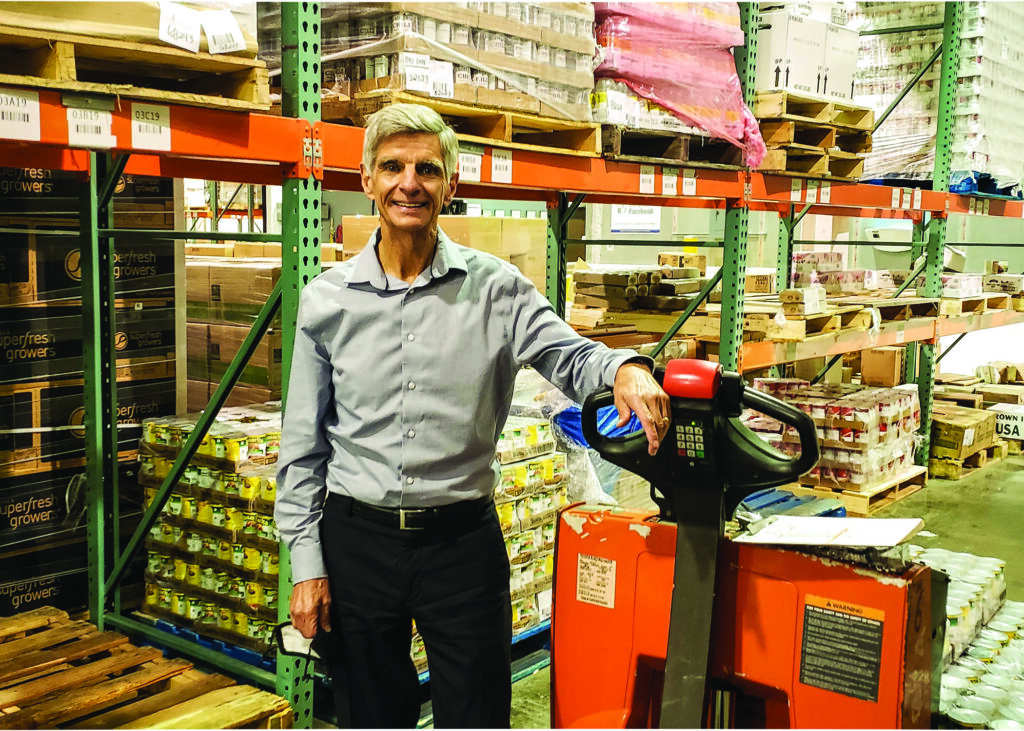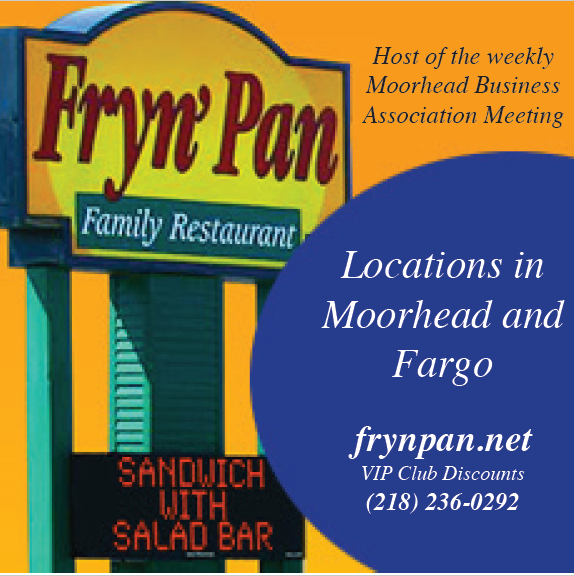
Moorhead’s Steve Sellent has headed the Great Plains Food Bank since 1990. Today the nonprofit supplies fresh and shelf-stable groceries to 194 partner agencies and 110 communities in Clay County and North Dakota — the equivalent of 14.4 million meals a year. (Photo/Nancy Hanson.)
Nancy Edmonds Hanson
Moorhead’s Steve Sellent says more than one-fourth of all food produced in this country never makes it to the dinner table. He has made it his life’s mission to help find that food and share it with those who are hungry.
For the past 30 years, Sellent has headed the Great Plains Food Bank. A fledgling nonprofit when he was hired, it has grown to the major source of groceries for community pantries and soup kitchens across North Dakota and here in Clay County. Last year it distributed the equivalent of 14.4 million meals that stocked the shelves of local partner agencies in 110 communities. This year, the need is up, way up.
“Since April 1, after COVID really hit, our distribution is up 44% over 2019,” he says. “We’re seeing a lot of people turning to us for the first time after losing jobs or being furloughed. Early on, that amounted to 24,000 additional people just in May and June. At the same time, the need among people we’re already serving has deepened.”
But help, too, has grown. In addition to several federal programs granting emergency funds – chief among them the U.S. Department of Agriculture – the food bank’s traditional sources of private support have also stepped up. “We have a large base of tremendously supportive donors,” he acknowledges. “We’ve seen a large proportion of new donors among those who support us. Corporations and foundations are doing their part, too, including some we hadn’t worked with before.”
That includes gifts like the nearly $100,000 check presented by Hornbachers Foods last week – all donated by the supermarkets’ customers in its 26th annual Check Out Hunger campaign.
All told, Great Plains’ annual budget of more than $35 million includes about $5 million in operating funds, all generated through grants and its aggressive fund-raising efforts. The balance represents the food products donated directly to the local organization by the food industry or received from similar sources through its participation in the Minnesota-based Second Harvest program.
The food distribution program, as Sellent explains it, is a match made in heaven between food growers, manufacturers, distributors, wholesalers and retailers and agencies like his. A portion of their products is inevitably left over due to erratic supplies, rising and falling demand, overstocks and other dilemmas. Food banks take it off their hands before it ends up wasted in the landfill – using what’s otherwise regrettable mistakes to do good works.
Back in 1990, when Sellent was hired as the fledgling food program’s seventh director in just six years of life, the dramatic landscape of food waste versus hunger was just coming into focus.
A native of Sabin, he had graduated from Moorhead schools and Minnesota State University Moorhead with a degree in business administration. He spent the first 16 years of his career, beginning as a part-timer in high school, working in the warehousing and transportation industry. At the same time, he was a local, regional and state leader with the Minnesota Jaycees. Among his volunteer service, he helped distribute cheese and butter through the USDA’s commodity program.
When he began searching for a new job, he recalls, he printed 100 copies of his resume. The first place he applied was at Lutheran Social Services of North Dakota, which then operated the food bank.
“It perfectly melded everything in my life up to that point … my education, my experience, my community involvement,” he reflects. “I threw the other 99 resumes away.”
Since then, the Great Plains Food Bank has grown from four employees to 38, along with an occasional corps of some 5,000 volunteers; from providing the equivalent of 1 million meals to nearly 15; from supplying about 40 agencies that fed the hungry, mostly in the Fargo-Moorhead area, to 194 pantries and soup kitchens in every corner of North Dakota plus Clay County; and – soon – from one distribution point in a downtown Fargo railroad warehouse to a vast structure that can shelve 53 semi-loads of groceries. Now located in the former GPK facility at 1720 Third Ave. N. in Fargo, the organization is readying second distribution center in Bismarck next month. Last year the food bank, through its partners, served 102,000 individuals – according to the president, one out of nine people in its service area.
The nature of both the food and the services Great Plains provides have changed and broadened over the years. “At first, 90% of the food we received was shelf-stable products,” Sellent notes. “As we became more efficient, we moved into the perishable food sector. Now more than half of what we distribute is perishables – produce, dairy, meat.” All of that is transported across the region in a fleet of three semi trucks, five refrigerated box trucks, and assorted smaller vehicles.
You may see those vans trundling around town on daily visits to pick up donations at Hornbachers, Family Fare and Cashwise, as well as Walmarts, Target stores and others with grocery departments. “It’s all good food,” Sellent emphasizes, “just nearing its sell-by date.” Meanwhile, semis filled with everything from pickles and pancake mix to produce pull in and out of the agency’s lot, bringing donations from nearby processors, wholesalers and brokers and their counterparts all over the region and beyond.
Several things have changed for Great Plains in recent years. In 2016, the nonprofit parted amicably with its longtime fiscal sponsor, LSS, and became an independent nonprofit. It has expanded its role from supplying partners who handled the direct distribution of food to the hungry in their communities to an array of direct distribution channels operated by the food bank itself – the Backpack program, for example, in which mostly elementary students receive parcels of food to tide them over the weekend; a mobile food pantry that makes scheduled stops in small towns around North Dakota; and the perishable food recovery program known locally as Daily Bread, which gathers restaurants’ left-overs for immediate distribution at feeding sites around Fargo-Moorhead. A pilot program involves partnering with clinics to offer nutritious, healthy food to people who might otherwise not be part of the system.
The biggest change, though – as Sellent describes it – is just emerging through his agency’s participation in Feeding America, a consortium of hunger-fighting groups across the country. “For 35 years, it’s been all about putting food on people’s plates,” he explains. “But we know just distribution won’t end hunger. We’re working together to try to reduce the need by looking at the root causes.”
After 30 years on the job, Sellent, who turns 65 at the end of 2020, is looking toward his next chapter. Earlier this year Melissa Sobolik was named president, taking on some of the external functions that he continues to handle as chief executive officer. When he reflects on retirement sometime in the next two years, he looks forward to more time for fishing, hiking, reading and spending time with his wife Nadine, a mental health therapist with the Counseling Center. They have two adult children: Jordan, an aerospace engineer with NASA who’s the father of their first grandson, born three weeks ago; and Joni, an occupational therapist in Fargo.
But the biggest advantage, he predicts, will be having more time … to volunteer. “It’s not going to be an end,” he predicts. “It will give me a chance to explore new ways to make a difference.”


